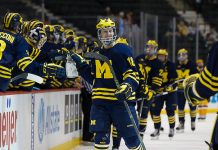Topics included in this blog post include Cornell, goaltending, and the Hobey Baker Award.
But we won’t be discussing Cornell goaltending.
Now there’s a surprise.
This isn’t a knock on Ben Scrivens – who’s been very solid this season with a .925 save percentage and a 2.10 goals-against average – but rather, a return to our previous discussion of Denver’s Marc Cheverie.
Cheverie’s star fell a bit last weekend with a loss to St. Cloud on Saturday and a fall from “Ryan Miller Land,” but it’s a moment in Friday’s win over the Huskies (which I watched on the NHL Network) that got me thinking.
Cheverie allowed a couple of goals that he’d want back against St. Cloud, and the Pioneers allowed the Huskies to pull back from a 4-1 deficit to make it 4-3 at the second intermission.
Then, late in the 13th minute of the third period, the Huskies got a couple of tough shots on goal during a flurry of activity in front of the Pioneer net. However, Cheverie made the saves he needed to make, leading to a rush the other way for the Pioneers and a Matt Donovan goal to restore the two-goal lead.
Cheverie finished the night with 24 saves on 27 shots, which looks pretty pedestrian on paper, but it was enough for him to be named Player of the Game on the Fox Sports Rocky Mountain broadcast. Why? Because the saves he made on that St. Cloud flurry in the third period were the turning point of the game, allowing Donovan to go the other way and score, effectively finishing off St. Cloud.
We can look at skaters’ statistics pretty easily, not just in terms of goals and assists, but futher breakdowns like game-winning goals, shorthanded goals, etc. We can even go deeper into the numbers and find “designer statistics” like goals when a player’s team is tied or losing. However, we don’t really do the same thing with goalies, which suggests that maybe, just maybe, the Ryan Miller standard isn’t fair. This, naturally, will not endear me to those Notre Dame fans who were very unhappy with me when I doubted the Hobey candidacy of David Brown two years ago, based largely on his numbers. To them, I say that we learn things as we get older.
Should the Hobey chances for a goalie like Marc Cheverie be based more on the saves he makes, or when he makes them? It’s worth thinking about.
Now, on to Cornell, a team I had the opportunity to see on Saturday night at the Red Hot Hockey Classic at Madison Square Garden. It was a great event once again – I don’t think the Rangers will have MSG that hot during the regular season – and it gave me a chance to take a look at Cornell’s high-scoring duo of Blake Gallagher and Colin Greening.
Gallagher and Greening are two of the nation’s top-five scorers in terms of points per game, with Greening mostly getting his points on assists. They both have themselves in the Hobey finalist mix, but in terms of candidates for the award itself, Gallagher seems the more attractive candidate at present.
Gallagher is the surprise of the season so far, as his nine goals in nine games are more goals than he had over the entire 2008-09 season, not to mention as many as he scored in his first two seasons combined. With 15 points in nine games, he’s No. 2 in the nation in points per game, second only to James Marcou of UMass, who’s getting it done largely with assists (and as we all know, “Hobey likes goals”).
Gallagher got his ninth against the Terriers, a power-play goal (more on that in a second), and I asked Mike Schafer about the last time one of his forwards had this kind of a hot hand. Said Schafer, “It’s been a while. Matt Moulson, who’s with the Islanders, is probably the last guy at Cornell who’s been on this kind of run at Cornell. Blake is just finding open spots, and guys are getting pucks to him. So, he continues to stay hot, and I hope he sustains it for the rest of the year.”
Now, as for Moulson, the longest goal-a-game average stretch I could find was six games, at the beginning of his senior year, and given that Moulson is probably the highest-profile Cornell alum in the NHL right now (by virtue of playing on a line with John Tavares), I think that makes it clear the kind of rarified air the native of Dartmouth, Nova Scotia is in at the moment.
So, how far can Gallagher go? At his current pace, he’s on track to have about 48 points on 29 goals and 19 assists by the end of the regular season. Call me a skeptic, but I have a bit of trouble believing that we’re going to see that from a guy who’s already surpassed his career total in goals. That said, Gallagher is coming off of a 28-point season a year ago, and I certainly expect him to surpass that by the end of the regular season. I don’t know where Gallagher will land exactly, but he definitely has the look of a guy who could be in the mix.
The main caveat that Gallagher may face here is the fact that he scores most of his goals (six of his nine so far) on Cornell’s mighty power play, which is clicking at a 30.1 percent clip. Some people think it makes a difference in terms of Hobey candidacy whether you score 5-on-5 or with the man-advantage. I disagree, for two reasons. First, no matter how many men are on the ice, you still have to put the puck in the net. Bottom line. Second, when you have a power play like Cornell’s, you make the opposition think a little bit more about taking penalties, and that can give you more breathing room during even-strength play. I think the greatest measure of a player’s value to his team is how he impacts the team and the game, and by that standard, Gallagher and Greening are extremely valuable, and very much worth following as the season goes along.
And really, how nice is it to talk Cornell and not use the word “system?”


